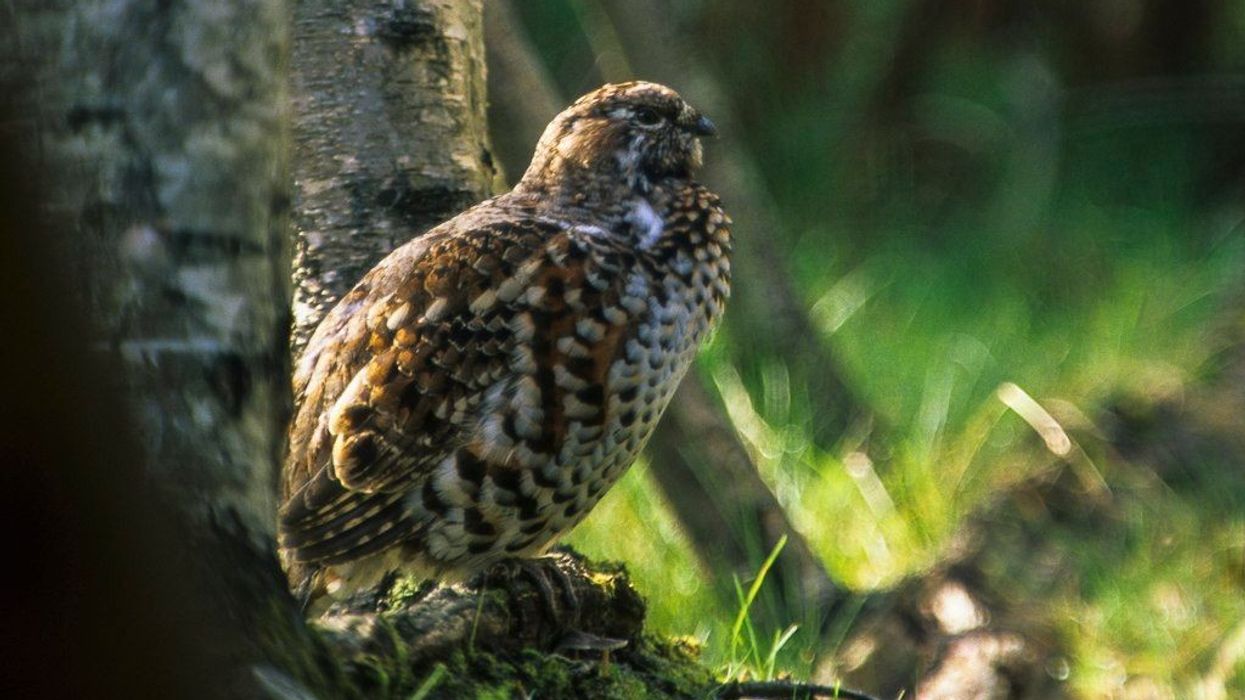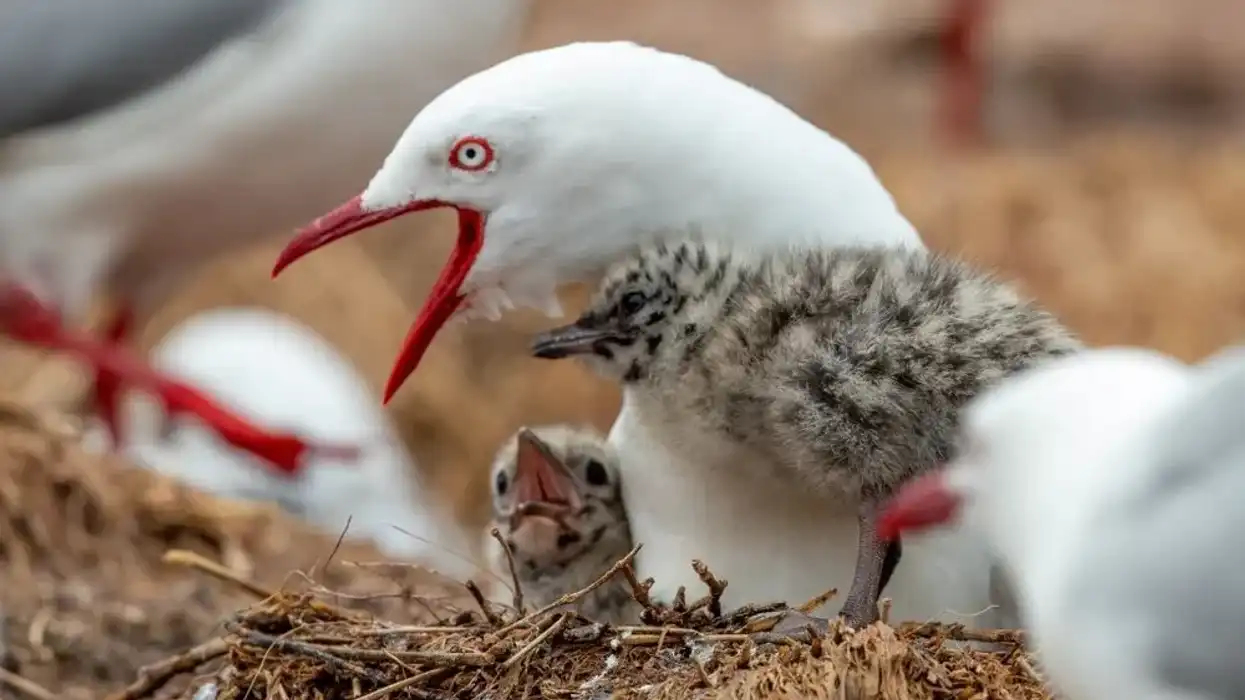A medium-sized grouse from the forests of the Appalachian Mountains and found across Canada and Alaska, the ruffed grouse is incorrectly identified as a partridge from time to time. This bird is often confused specifically with the gray partridge, which is a fowl found in open regions instead of woodlands.
The ruffed grouse is the only species comprising the genus Bonasa and is a non-migratory bird.
If you like these facts, you could also read our spruce grouse facts and blue grouse facts.
Ruffed Grouse Interesting Facts
What type of animal is a ruffed grouse?
The ruffed grouse (Bonasa umbellus) is a medium-sized grouse that lives in the forests of the Appalachian Mountains throughout Canada to Alaska. It is a non-migratory bird species and the only one within the genus Bonasa.
What class of animal does a ruffed grouse belong to?
The ruffed grouse (Bonasa umbellus), according to the Cornell Lab of Ornithology, is a North American bird belonging to the Aves class.
How many ruffed grouses are there in the world?
The exact estimate of the ruffed grouse's population is unknown, but they are in abundance and are not a concern.
Where does a ruffed grouse live?
The ruffed grouse is a game bird species that is broadly located throughout North America. Ruffed grouse live in 38 of the 50 states, including New York, and in all Canadian Provinces.
They range all through the Appalachian Mountains from Alabama to Labrador. While Minnesota boasts the pinnacle ruffed grouse production within the United States, these birds are not uncommon in the northern and western United States further to Canada.
What is a ruffed grouse's habitat?
Often thought of like a bird species of the deep forest, ruffed grouses thrive in habitats of young, aspen forests, and brushlands. When aspen isn't available, lowland brush, oak, and dense bushes are also habitat options for them. Male ruffed grouse are a welcome sight at bird feeders in neighborhoods wherein the natural habitat is available.
Who do ruffed grouses live with?
These birds live solitary lives. Male and female ruffed grouse live separately until the breeding season. The male establishes himself amongst different male ruffed grouse via means of drumming and fighting. He remains in his territory for the course of his life, chasing different males away and courting females.
How long does a ruffed grouse live?
Although it is thought that individual birds of this species may also live as long as eleven years, the common lifespan for ruffed grouse is a lot less, and only a few birds make it past seven or eight years of age.
How do they reproduce?
The breeding season for the ruffed grouse starts from spring, from around late April to May. The male uses a drumming sound to draw females to their territory.
A male starts the drumming sound from the same spot, using the same log or stump for many years.
The male attempts to pick out an ideal habitat for their territory, in which the female, their young chicks, and themselves can comfortably settle. A good territory includes ease of access for locating food, and appropriate shelter, and cover from predators during winter when there is snow.
For the females, the most important aspects of territory are the ability to find food for themselves and to look after themselves and their chicks. Therefore we can say, those with territories that happen to be an ideal habitat may have more success with attracting mates.
Male grouse stay on their territories and retain the same mate till the early summer season.
Then they set about feeding intensively together to prepare for the approaching early winter season. The female lays about 9-14 eggs on average, and it is up to them to rear the chicks.
What is their conservation status?
A bird's conservation status is dependant on the populations of the species. So, these North American birds are abundant in population and have been categorized as of Least Concern by the IUCN Red List. However, the populations of these bird species are slowly declining.
Ruffed Grouse Fun Facts
What do ruffed grouse look like?

Ruffed grouse have different colors, gray and brown. In the gray morph birds, the head, neck, and lower back are gray-brown in color.
The breast is light with barring, and there is a lot of white on their bottom and wings. Generally, these birds have a variegated appearance which means the throat is frequently lighter.
The tail is basically the identical brownish grey, with normal barring and a large black band close to the tail. The brown morph birds have tails of the same shade and pattern.
However, the rest of the plumage is a lot more brown, giving the description of a more uniform bird with much less light plumage underneath the wings and a conspicuously gray tail.
There are all kinds of intergrades among the maximum regular morphs. They even have a crest on the top of their head, which now and again lies flat.
Both sexes are marked and sized, making them hard to tell apart, even in hand. Another pretty correct sign is that rump feathers on the wings with one white dot suggest a female, and rump feathers with a couple of white dots suggest a male.
How cute are they?
They are quite cute to look at because of their appearance. Their chicks are especially cute and small.
How do they communicate?
These birds communicate with the use of hissing, chirping, peeping, and drumming sounds. Ruffed grouse are commonly solitary however may also gather in small groups at feeding spots.
They are commonly energetic at some point of the day and maybe often be seen foraging alongside road beds throughout the early morning and late afternoon. Ruffed grouse may seem like unusually quiet birds, although they do make call sounds to communicate. Female calls consist of a nasal squeal or a hiss-like alarm sound and a 'peet peet' sound.
How big is a ruffed grouse?
They are around 16-20 in (40-50 cm) in length and 18 in (45 cm) tall.
How fast can a ruffed grouse fly?
A ruffed grouse cannot fly for a long period of time. Their top speed is 20 mph (32 kph).
How much does a ruffed grouse weigh?
A ruffed grouse weighs 0.99-1.6 lb (450-750 g) which is light according to its length.
What are the male and female names of the species?
There are no different names for the males and females of this species.
What would you call a baby ruffed grouse?
The baby of this bird is called a chick.
What do they eat?
The diet of the ruffed grouse consists of fruits, buds, green leaves, and insects. They search for food in the forest by digging the ground or picking up buds and fruits from the ground that fall from the tree.
Are they dangerous?
Ruffed grouse aren't often aggressive, but they are very territorial during nesting.
Would they make a good pet?
No, grouse do not make good pets. They are wild birds and have a tendency to be pretty frightened and flighty.
Did you know...
Humans are also one of the predators of the ruffed grouse as they are hunted for their meat. In some countries, it is illegal to even raise ruffed grouse, let alone kill it.
These North American bird populations rely on 'drumming' with their wings in the forest. This means that they flap them repeatedly to create a low-frequency sound to attract a mate during their courtship display.
Some other birds to look into are the sandgrouse, sharp-tailed grouse, dusky grouse, and sooty grouse.
What is the difference between a ruffed grouse and a spruce grouse?
Spruce grouse live in lowland conifer forests within the Adirondacks. Ruffed grouse live in upland hardwoods state.
How many eggs does a ruffed grouse lay?
The female ruffed grouse lays 9-14 eggs on an average in a single brood during spring. Their nest needs to be in good cover and away from predators so that their nesting goes well.
Here at Kidadl, we have carefully created lots of interesting family-friendly animal facts for everyone to discover! Learn more about some other birds from our moorhen facts and military macaw facts pages.
You can even occupy yourself at home by coloring in one of our free printable ruffed grouse coloring pages.










